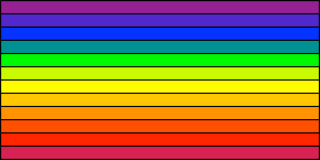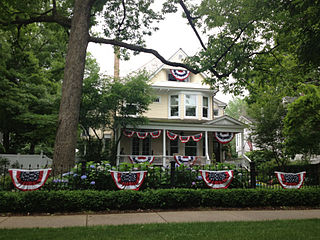
A flag is a piece of fabric with a distinctive design and colours. It is used as a symbol, a signalling device, or for decoration. The term flag is also used to refer to the graphic design employed, and flags have evolved into a general tool for rudimentary signalling and identification, especially in environments where communication is challenging. The study of flags is known as "vexillology" from the Latin vexillum, meaning "flag" or "banner".

Mecklenburg is a historical region in northern Germany comprising the western and larger part of the federal-state Mecklenburg-Vorpommern. The largest cities of the region are Rostock, Schwerin, Neubrandenburg, Wismar and Güstrow.

A national flag is a flag that represents and symbolizes a given nation. It is flown by the government of that nation, but usually can also be flown by its citizens. A national flag is typically designed with specific meanings for its colours and symbols, which may also be used separately from the flag as a symbol of the nation. The design of a national flag is sometimes altered after the occurrence of important historical events. The burning or destruction of a national flag is a greatly symbolic act.

Marburg is a university town in the German federal state (Bundesland) of Hesse, capital of the Marburg-Biedenkopf district (Landkreis). The town area spreads along the valley of the river Lahn and has a population of approximately 72,000.

The flag of Germany is a tricolour consisting of three equal horizontal bands displaying the national colours of Germany: black, red, and gold. The flag was first adopted as the national flag of modern Germany in 1919, during the Weimar Republic, until 1933.

A rainbow flag is a multicolored flag consisting of the colors of the rainbow. The designs differ, but many of the colors are based on the seven spectral colors of red, orange, yellow, green, blue, indigo, and violet that compose the visible light spectrum. The actual color attributed as "blue" is cyan.

The national flag of Estonia is a tricolour featuring three equal horizontal bands of blue (top), black, and white. The normal size is 105 by 165 centimetres. In Estonian it is colloquially called the "sinimustvalge", after the colours of the bands.

Three successive designs served as the official national flag of the Confederate States of America during its existence from 1861 to 1865. The flags were known as the "Stars and Bars", used from 1861 to 1863, the "Stainless Banner", used from 1863 to 1865, and the "Blood-Stained Banner", used in 1865 shortly before the Confederacy's dissolution. A rejected national flag design was also utilized as a battle flag by the Confederate army and featured in the "Stainless Banner" and "Blood-Stained Banner" designs. Although this design was never a national flag, it is commonly recognized as a symbol of the Confederacy.

Działdowopronounced [d͡ʑau̯ˈdɔvɔ] is a town in north-central Poland with 24,830 inhabitants (2006), the capital of Działdowo County. As part of Masuria, it is situated in the Warmian-Masurian Voivodeship, Działdowo belonged previously to Ciechanów Voivodeship (1975–1998). The town is a major railroad junction connecting the capital city of Warsaw with Gdańsk and Olsztyn to the north.

Radebeul is a town in the Elbe valley in the district of Meißen in Saxony, Germany, a suburb of Dresden. It is well known for its viticulture, a museum dedicated to writer Karl May, and a narrow gauge railway connecting Radebeul with the castle of Moritzburg and the town of Radeburg. The Meißen area, where Radebeul is located, is one of the northeasternmost areas where wine is grown in the 21st century.

Togoland was a German Empire protectorate in West Africa from 1884 to 1914, encompassing what is now the nation of Togo and most of what is now the Volta Region of Ghana, approximately 77,355 km2 in size. During the period known as the "Scramble for Africa", the colony was established in 1884 and was gradually extended inland.

FC St. Gallen 1879 is a Swiss football club based in St. Gallen, in the Canton of St. Gallen. In the 2019–20 season the club plays in the Swiss Super League.

Badonviller is a commune in the Meurthe-et-Moselle department in northeastern France.

This is a list of international, national and subnational flags used in Europe.

Garz is a town in the county of Vorpommern-Rügen in the German state of Mecklenburg-Vorpommern. The town is administered by the Amt of Bergen auf Rügen, in the town of the same name.

"Red Flag" is a song by Canadian rock group Billy Talent. It was released in September 2006 as second single from their second album, Billy Talent II.

The coat of arms of the German state and city of Hamburg is a kind of a national emblem. The coat of arms and the flags are regulated by the constitution of Hamburg and law. The colors of Hamburg are white and red. One of the oldest versions of the castle is found on a seal in 1241.

There are three flags of Hamburg, Germany. The Landesflagge, the State flag of Hamburg (Staatsflagge) and the admiralty flag (Admiralitätsflagge) consist of the Coat of arms of Hamburg on a red flag.

Bunting is any festive decorations made of fabric, or of plastic, paper or even cardboard in imitation of fabric. Typical forms of bunting are strings of colorful triangular flags and lengths of fabric in the colors of national flags gathered and draped into swags or pleated into fan shapes.

Displaying flags of the Confederate States of America in the modern era began as a response to the civil rights movement of the 1950s and 1960s and continues to this day in support of white nationalist and white supremacist movements. The flags' revival began with Senator Strom Thurmond's Dixiecrats in reaction to growing public support for racial equality, alongside opposition to civil rights in 1948. Although never an official national flag, the most popular and widely recognized symbol of the Confederacy is a rejected national design that was used as a battle flag.




























